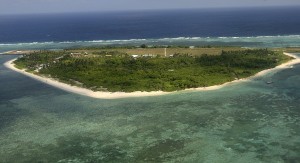
Pag-asa Island, part of the disputed Spratly group of islands, in the South China Sea located off the coast of western Philippines. AP FILE PHOTO
The Philippines has halted all “planned maintenance activities” and related works on Pag-asa (Thitu) Island and seven other islands in the Spratly archipelago that the country occupies, Malacañang said on Sunday.
The temporary halt came “in response to our call for a moratorium” on various types of activities in the disputed waters, Communications Secretary Herminio Coloma Jr. said.
Coloma said it was proof of the country’s “integrity” and that it was standing on “high moral ground” concerning the “Triple Action Plan” it proposed during the Association of Southeast Asian Nations (Asean) foreign ministers’ meeting, hosted by Burma (Myanmar) in August last year.
Under the plan, which China rejected, Manila suggested Beijing curb its actions around reefs, atolls and rocks in the West Philippine Sea, part of the South China Sea within the Philippines’ 370-kilometer exclusive economic zone.
China guns on PH isles
Asked by the Inquirer about reports that artillery had been discovered on at least two Chinese land reclamation sites in the Spratlys, Coloma said the government was still verifying the information.
US defense officials disclosed on Friday that China had put two large artillery vehicles on one of the artificial islands it was building in the South China Sea.
The Pentagon, however, would not release any photos to support the officials’ contention that the vehicles were there.
The Asia Maritime Transparency Initiative, which monitors developments in the South China Sea, said analysts had previously identified artillery on at least two of the Chinese land reclamation sites in the Spratlys: the Philippine-claimed Kagitingan and Burgos reefs.
A Vietnamese defense official said the report about the weapons, if true, was a “very worrying development.”
Philippine plan
Speaking on state-run Radyo ng Bayan, Coloma said that “overall, the ongoing [Chinese] reclamation activities have caught the attention of many countries, which viewed these activities [as] creating tension in the region.”
“That is why, in August 2014, the Philippines declared during an Asean conference its Triple Action Plan,” he said.
“Under the plan, the first point was our call for a moratorium on ongoing activities in the maritime entitlements in the South China Sea, including Pag-asa Island, which has long been occupied by the Philippines,” he said.
The plan also called for the Asean members’ “adherence to the Declaration on the Conduct of Parties in the South China Sea, which is expected to lead to the [conclusion] of [a] legally binding code of conduct based on the principle of Asean centrality, which should be decided by Asean along with China,” he said.
“The third point was the Philippines’ motion for United Nations arbitration to clarify our position on the 1982 UN Convention on the Law of the Sea,” he said.
Overall, Coloma said, “our country was clearly referring to a rules-based and diplomatic approach [to] settling disputes related to the South China Sea or West Philippine Sea.”
Halt to island-building
On US Defense Secretary Ashton Carter’s call for an “immediate and lasting halt” to reclamation works in disputed waters in the South China Sea, Coloma said in Filipino: “It is clear that our Triple Action Plan runs in line with Secretary Carter’s proposal.”
Speaking at an annual security dialogue in Singapore on Saturday, Carter called for an “immediate and lasting” halt to China’s island-building in the South China Sea.
But Carter also called on other claimants to territory in the sea to stop their own construction activities in adherence to the 2002 agreement between Asean and China.
He acknowledged that other Spratly claimants have developed outposts of differing scope and degree, including Vietnam with 48; the Philippines with eight; Malaysia with five; and Taiwan with one.
But those outposts were built before the 2002 agreement, and were never done at the pace and scale of China’s land reclamation works in the Spratlys, which in just the past 18 months had added about 800 hectares to at least five reefs in the area.
Recent satellite photos showed what appeared to be an airstrip under construction on one of the artificial islands. The airstrip looked adequate to receive military-type aircraft.

